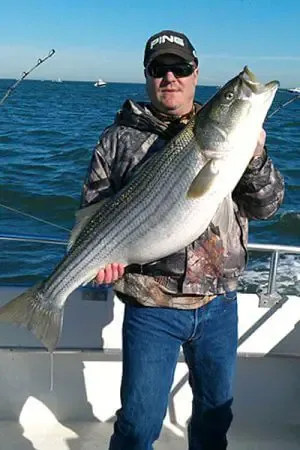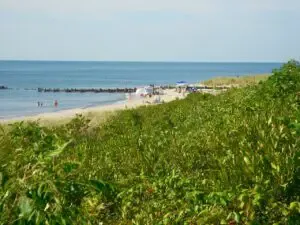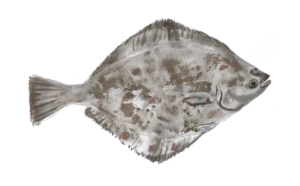Of the many traits that make the striped bass one of America’s most popular game fish — its vigor, sheen, and particular black stripes — the best may just be the striper’s tendency to feed close to the shore. The striped bass’ passion of shore feeding means that any shore-bound angler can handily hook a fish of 30 to 50 plus pounds. Once you know the basics of striped bass fishing from the shore even novice anglers can draw fish to them and enjoy a huge haul.
Of course, striped bass fishing from the shore looks quite different than fishing striped bass through other methods. Before you set out, you’ll need to become familiar with how to choose the perfect piece of shoreline to cast from and what time of day will yield the biggest catch. Additionally, you’ll want to understand why striped bass feed on the shore so you can choose the right lures and gear for the job. There is a good reason why regulars often refer to striped bass as “rockfish.” These shore loving fish are predictably happy when hanging around the rocks.
Be sure to check out our other article to learn about the Best Fishing Reels for Striped Bass.
Why are Striped Bass Attracted to the Shore?
Striped bass fish are attracted to the shoreline because the rocky nature of the shore boasts all the necessary ingredients for a striper to thrive. The physical structure of a shoreline — crags, rocks, and sand — give bass a chance to pounce on unsuspecting prey without being seen. The foamy suds accumulated on the shore also provide a similar benefit. Stripers love to pin their prey up against the rocky crags resulting in big feed hauls. It’s the reason why stripers can quickly grow to be well over 50+ pounds!
A shoreline proves a varied habitat that offers a diverse range of prey for stripers to choose from. It isn’t uncommon for anglers to harvest a striper only to find a stomach full of lobster, squid, flounder, and other types of fish. In other words, when a striper hangs out around the rocky shoreline, they can almost always find something delicious to eat. The shoreline also proves a safe haven for stripers to outwit boaters. In many ways, shore-caster anglers garner bigger striped bass hauls because they can go where boaters only wish they could be.
Reading the Shoreline to Catch Striped Bass
Before you can cast a line and try to catch striped bass from the shore, you’ll want to know how to read the shoreline. Approaching any old section of shore won’t assure great results. Instead, you want to attempt to read the shoreline for two specific things: where the fish could be holed up and where you could possibly land those fish. Don’t Blink-cast and hook-up while standing a great distance from the whitewash. This is a catastrophe waiting to happen as it compromises you and lessens the odds of catching a big bass.
Rather than aimlessly choosing any old piece of rocky shoreline, look to the formation of the shore itself. Try to read bedrocks and rocky crags. You’ll also want to take note of whitewater, as this is your bread and butter as a shore caster. Rocky shorelines where waves crash prove a striper-holding area of sorts. There should be plenty of foam and a familiar “hiss” of waves crashing. That foam is where you want to cast your line.
Striped bass will often cluster in those waves and foamy crags to seize an opportunity to snag prey upon the shoreline. The waves allow them to get as close as they can to the rocks, before gently being pulled back into deeper waters. If you really want to know the best spot upon the shoreline, go for the green seam where white water meets clear water. Striped bass are all about hanging around edges as they can easily ambush prey.
Shorelines with varied structures will always fish best. The diverse landscape makes for more varied prey for the bass. A rocky platform boarding a sandy beach or even an inlet could garner a big haul of stripers. Don’t always go for the most uniform rocky structure as the biggest bass won’t be found here. They are far too clever and opportunistic. Go for a diverse landscape and try to move between environments that are close in proximity to one another.
When to Catch Striped Bass From the Shore
When it comes to catching striped bass from the shoreline there can be some confusion as to what time of day is best for an angler to cast out and set up shop. While you can generally catch striped bass at any time of day, effectiveness can vary based on the time of year. For example, during the early spring and fall, migrating striped bass will bump into schools of migrating batfish, resulting in an outright smorgasboard for the stripers in broad daylight. During these seasons, setting up in the late morning or early afternoon will help you take in a rather large haul.
However, most of the year fishing within bankers hours will not get you that trophy bass you seek. Big bass tend to sulk in deeper waters when the sun is high. If you try to fish too early in the day, you aren’t likely to catch a big striper. These fish wait until darkness to move into the shallows of the shoreline to hunt. Once night falls, stripers fall into a feeding pattern which makes it easier to predict their behaviors and habits.
With that said, striper fishing at night will get you a bigger fish and a higher yield. You’ll also be better able to predict feeding habits. When it comes to getting comfortable with night fishing, familiarize yourself with areas you wish to fish during the day. That way, when night falls, you’ll know right where to cast and set up.
Best Tactics for Fishing Striped Bass From the Shore
Once you choose a nice spot along the shoreline and find that coveted green seam, you’ll want to get to know a few tacts for fishing striped bass from the shore. Shore fishing can be a new experience if you’ve never done it before.
Take Advantage of the Rocks
There’s a reason striped bass are lovingly referred to as “rockfish.” As mentioned above, look for shorelines with a diverse and varied rocky landscape. Submerged rock piles and white foam are great indicators that a big striper cluster may be lurking within. Don’t overlook rock piles that exist along the bank. When you first get to your ideal spot, stay quiet, and stand way back while cast along the shoreline. After you fished in a big closer you can cast out even farther.
Cast to the Current
When striped bass fishing from the shore always cast to the current. Start by looking for big rips or areas in which you can see the current constantly moving. Once you see ripples caused by the current, you can bet that there is either an obstruction underneath or a total drop off. While you can catch stripers upstream or downstream of the rip, your best chance is to cast right on top of that current. Keep in mind that a lure that moves downstream with the current looks far more natural to a striper than a lure moving against the current.
Use Blood Worms to Your Advantage
One of the greatest thrills of striped bass fishing from the shore is that you can utilize a variety of baits and lures due to the striper’s varied diet. Once solid choice if you want to haul in a big striper is to use blood worms to your advantage. Stripers absolutly love blood worms! These fish have an amazing sense of smell and can reportedly smell blood worms from a quarter mile away. You can also use lures once the stripers are called in from the smell of the blood worms.
Use Search Baits
While hard plastic lures may not be every anglers cup of tea, they can be great for casting from the shore. When fishing for striped bass, almost any lure designed to be jerked along well beneath the surface of the water will work well. However, if the water is less than 4-feet deep you may want to try floating plugs. Otherwise, jerkbaits that suspend will be great for striped bass fishing. Just make sure you have strong hooks that can mash the barbs on the trebles as you go along.
Go For the Top
Many anglers avoid top water fishing for striped bass until water temperatures are at least 65-degrees. However, when migration season is in swing and there are hungry fish to be caught, don’t be afraid to start a little early. Water will warm up fast in shallow spots along the shore on sunny days anyway. Strive to use big splashy chuggers with strong hooks or even a teaser fly to catch those coveted migrating stripers.
Essential Gear for Striped Bass Fishing From the Shore
Shoreline fishing does require some different gear than fishing from a boat or river’s edge. Firstly, if you’re used to casting with long rods, you’ll want to ditch that long stick for something different. Despite what many anglers may think casting is not the main priority with shore fishing. On a rocky shore, stripers tend to reside just about under your feet. You don’t need a long rod. Instead, you simply need a rod, reel, and line that can effectively lock down a 30+ pound striper who is determined to stay in the shallow waters of the coast.
That means you’ll also want to ditch those lightweight fast-action blanks. They won’t work along a rocky coast where the environment is unsettled and unforgiving. Opt for a fishing rod with a moderate action blank that proves pliable toad the tip and has just enough starch at the grip to reel in a big striper. Make sure any rod you take when striped bass fishing from the shore can pass the 50-pound test.
Stripers can vary in size. You don’t want to miss out on that coveted trophy bass because your rod can’t handle the excessive weight. Use a rod that can stand up to buckling down on a big bass with a powerful reel and at least a 50-pound braid. Too often when fishing from the shore, anglers make the mistake of bringing materials that are too light for the job.
Aside from a sturdy rod and powerful reel, you’ll want to ensure that you have boots that can handle the slippery coastline. Rocks aren’t just wet, they are often covered in slick algae that could prove hazardous. Lip Gripper boots with studded soles will provide the best traction. Since you may want to change positions throughout the day, you’ll need to be able to move with ease and stand your ground when reeling in a striper.
If you plan on fishing at dusk, you could also benefit from mirror lens glasses which can help you to spot fish in low-light conditions and may prove a helpful tool for scanning the rocky crags for movement.
Catching A Trophy Rockfish

At the end of the day, catching a trophy rockfish isn’t rocket science. Once you understand the shoreline and the habits of striped bass along these rocky crags, you can easily set yourself up for success. Be mindful of the seasons and the water temperature, as this can impact the time of day in which you should be casting out and setting up. Remember, late spring and fall will be ideal for mid-day fishing along the shore. During the summer, you may want to opt for fishing at dusk or at night.
Striped bass are magnificent creatures that captivate and inspire anglers to know their craft. Fishing from the shoreline can yield some of the biggest bass in a given region. Don’t be surprised if you pull in a fish that weighs well over 50 pounds! The varied feeding opportunities of the rocky shoreline make them a true haven for these fish. As an angler, your job is to seize on their opportunities as well as your own for a catch you can be proud of.



